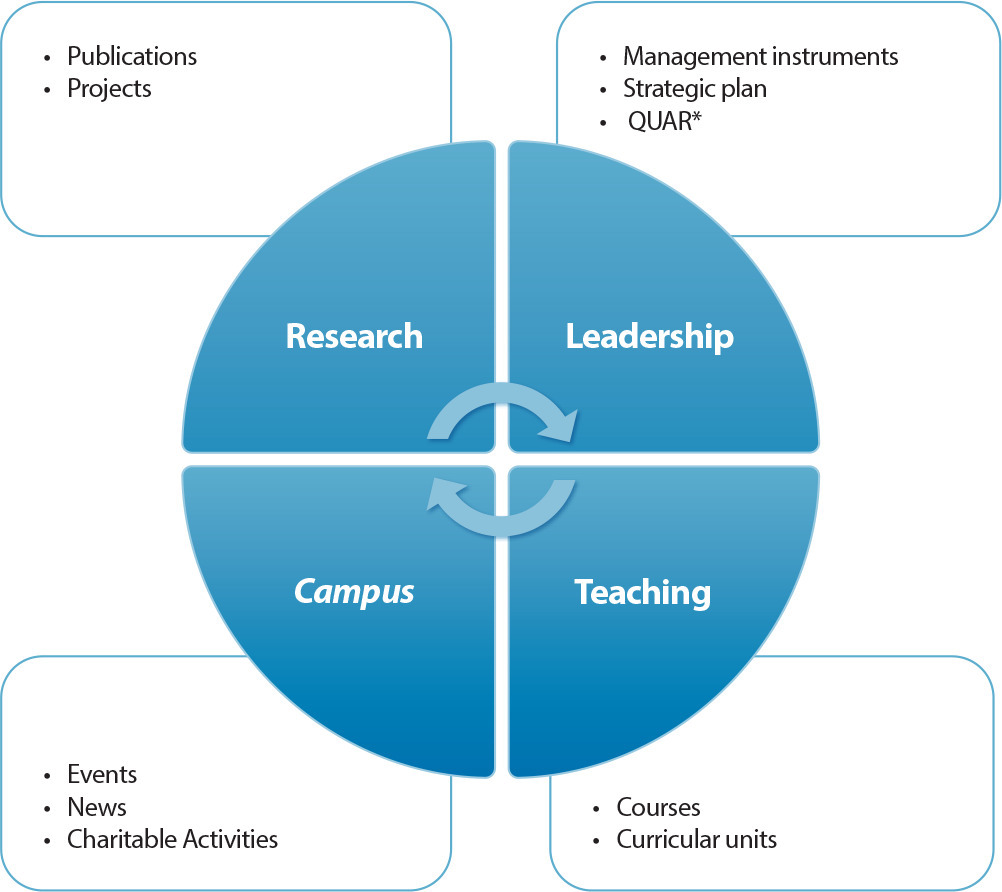-
ORIGINAL ARTICLE01-10-2024
Nursing students and the internet: a reflection of digital ethics
Revista Brasileira de Enfermagem. 2024;77:e20230459
Abstract
ORIGINAL ARTICLENursing students and the internet: a reflection of digital ethics
Revista Brasileira de Enfermagem. 2024;77:e20230459
DOI 10.1590/0034-7167-2023-0459
Views0See moreABSTRACT
Objectives:
to identify how first-year nursing students use cyberspace and propose an orientation guide with criteria guiding the use of cyberspace.
Methods:
qualitative and descriptive research, carried out with 24 nursing students from a federal public institution in Rio de Janeiro. Data collection was carried out through semi-structured interviews. Data analysis occurred using IRAMUTEQ®. The research was approved by the institution’s Research Ethics Committee.
Results:
students use cyberspace to communicate, study, find “cool things”, share photos and memories. Furthermore, they are concerned about hate speech, intolerance and fake news. The good and bad sides and the types of technologies most used were also portrayed.
Final considerations:
the moral and ethical values of physical coexistence, together with awareness of individual responsibility, are the pillars for using cyberspace. The guide comes as an awareness tool.
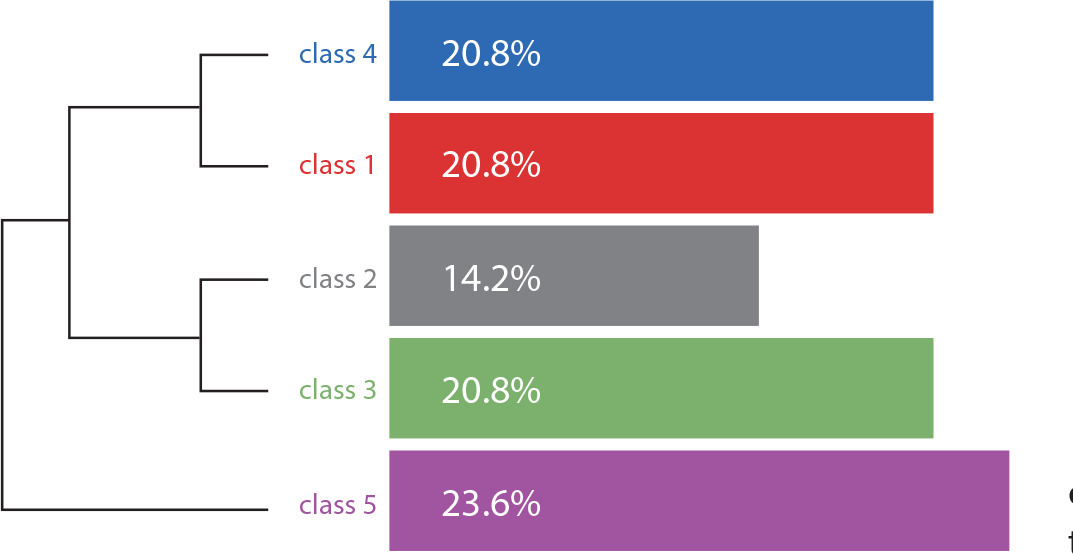
-
ORIGINAL ARTICLE01-10-2024
Maternity behind and beyond bars: analysis from the perspective of protection bioethics
Revista Brasileira de Enfermagem. 2024;77:e20220576
Abstract
ORIGINAL ARTICLEMaternity behind and beyond bars: analysis from the perspective of protection bioethics
Revista Brasileira de Enfermagem. 2024;77:e20220576
DOI 10.1590/0034-7167-2022-0576
Views0See moreABSTRACT
Objective:
to analyze how motherhood is expressed in female prison units from the perspective of Bioethics of Protection.
Method:
qualitative research with an ethnographic approach, developed in two women’s prison units. Participantes were: six mothers deprived of liberty, 15 health professionals, and nine prison officers. For data collection, semi-structured interviews and descriptive observation were used. Data analysis was based on the Content Analysis technique, thematic category.
Results:
three categories emerged: women and children violated behind bars (inequities); mothers and children in prison exacerbating imbalances, tensions and conflicts; and limits and references for resocialization.
Final Considerations:
the Bioethics of Protection proposal appears as a valid tool for the analytical direction of the process of confronting issues in the scope of public health in prison units, considering vulnerable groups and aiming at equity and human dignity.
-
ORIGINAL ARTICLE01-10-2024
Self-harm in the two years of greatest restrictions during the covid-19 pandemic: a cross-sectional study
Revista Brasileira de Enfermagem. 2024;77:e20240289
Abstract
ORIGINAL ARTICLESelf-harm in the two years of greatest restrictions during the covid-19 pandemic: a cross-sectional study
Revista Brasileira de Enfermagem. 2024;77:e20240289
DOI 10.1590/0034-7167-2024-0289
Views0See moreABSTRACT
Objective:
to analyze occurrence of self-harm, sociodemographic profile of victims and referrals in the first 24 months of the COVID-19 pandemic in São Paulo.
Method:
cross-sectional study carried out by the Notifiable Diseases Information System with data on self-harm in São Paulo. The period outlined was March 2020 to February 2022. R (4.0.2) software and chi-square test were used.
Results:
there were 15,946 incidents. Victims were young, white, single, heterosexual women. There was high incidence of people with previous mental disorders more than once and without clear motivation. The method used was poisoning/intoxication. There was a considerable number of referrals to the health network, although not totalitarian.
Conclusion:
the years of greater insecurity in relation to the pandemic have given rise to self-harm cases with peculiar characteristics. Agile health policies must be applied in atypical conditions, such as pandemics, especially for adolescents/young people with previous mental disorders.
-
REVIEW01-10-2024
Health of quilombola children as a challenge for the Sustainable Development Goals: a scoping review
Revista Brasileira de Enfermagem. 2024;77:e20240106
Abstract
REVIEWHealth of quilombola children as a challenge for the Sustainable Development Goals: a scoping review
Revista Brasileira de Enfermagem. 2024;77:e20240106
DOI 10.1590/0034-7167-2024-0106
Views0See moreABSTRACT
Objective:
to map the literature on quilombola children’s health and its relationship with the Sustainable Development Goals.
Method:
a scoping review, which followed the JBI protocol and the Preferred Reporting Items for Systematic reviews and Meta-Analyses extension for Scoping Reviews. Searches were conducted in the LILACS, BDENF, Web of Science, Scopus, MEDLINE databases and Google Scholar platform. The research protocol was registered in the Open Science Framework.
Results:
eighteen articles out of 2,055 studies were selected as relevant for this study. The articles were grouped into four axes: Access to healthcare services; Nutritional aspects of quilombola children; Health problems of quilombola children; and Care for quilombola children. The relationship between these articles and SDGs 1, 3, 4, 6 and 10 was observed.
Final considerations:
the study provided an extremely important mapping of the theme of quilombola children’s health and themes related to the Sustainable Development Goals.
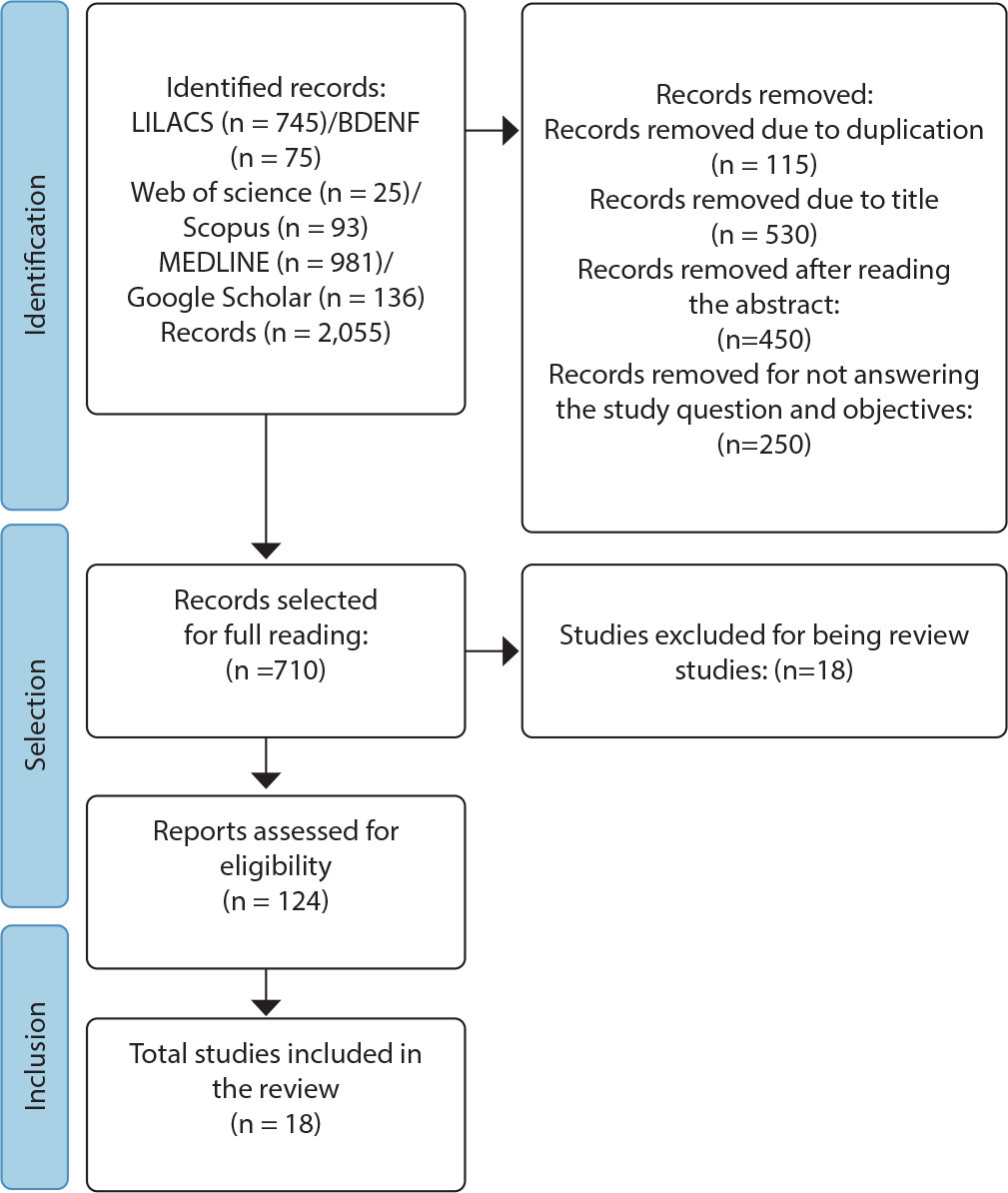
-
REVIEW01-10-2024
Prevalence and exposure variables of latent infection by mycobacterium tuberculosis in healthcare workers
Revista Brasileira de Enfermagem. 2024;77:e20240052
Abstract
REVIEWPrevalence and exposure variables of latent infection by mycobacterium tuberculosis in healthcare workers
Revista Brasileira de Enfermagem. 2024;77:e20240052
DOI 10.1590/0034-7167-2024-0052
Views0See moreABSTRACT
Objectives:
To identify in the scientific literature the prevalence, diagnostic methods, and exposure variables of latent infection by Mycobacterium tuberculosis in healthcare workers.
Methods:
An integrative review of the scientific literature based on the following review question: What are the available scientific evidence in the literature that address the prevalence of latent infection by Mycobacterium tuberculosis in healthcare workers and its association with possible risk factors among these workers?
Results:
Being a physician or nurse, being older, and being male were generally associated with higher prevalences. The study also showed that interferon-gamma release assays were more commonly used as a diagnostic method compared to skin tests.
Conclusions:
More studies are needed regarding the epidemiology of latent infection by Mycobacterium tuberculosis in the context of healthcare workers, aiming for higher impact actions that contribute to the reduction of tuberculosis worldwide.
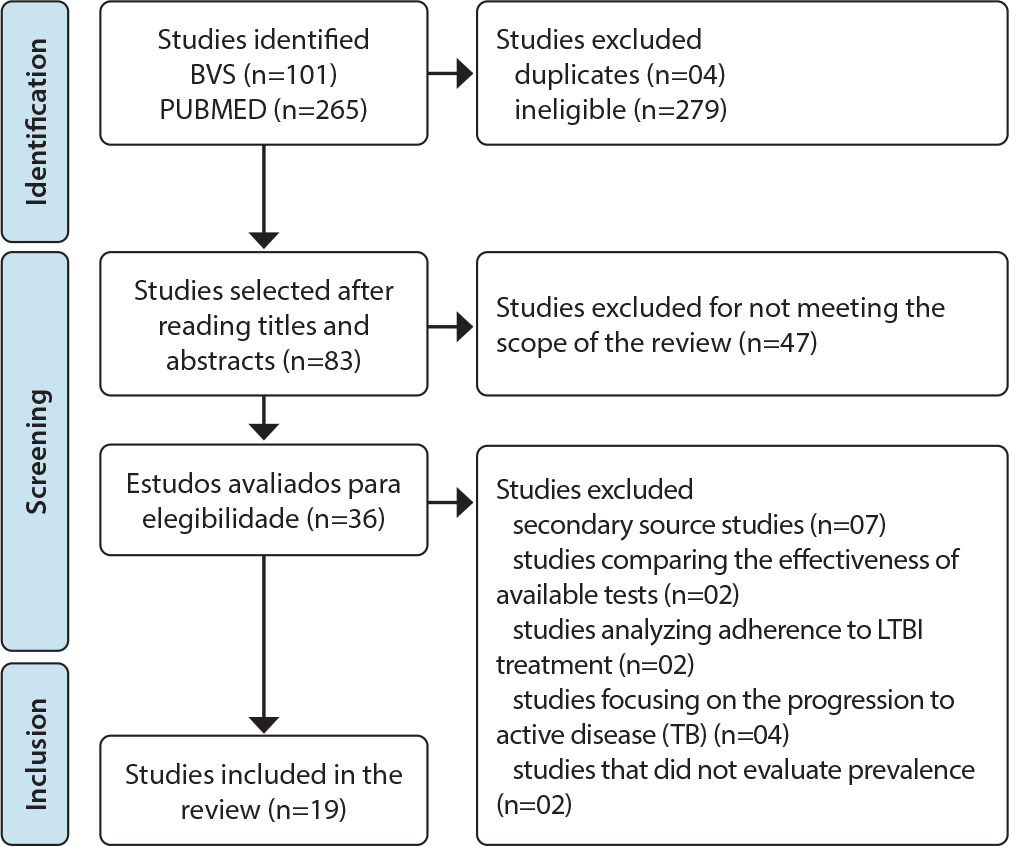
-
ORIGINAL ARTICLE11-27-2023
Incidents in the context of pre-hospital care by ambulances: contributions to patient safety
Revista Brasileira de Enfermagem. 2023;76(5):e20220657
Abstract
ORIGINAL ARTICLEIncidents in the context of pre-hospital care by ambulances: contributions to patient safety
Revista Brasileira de Enfermagem. 2023;76(5):e20220657
DOI 10.1590/0034-7167-2022-0657
Views0See moreABSTRACT
Objectives:
to analyze the occurrence of incidents in the context of mobile terrestrial pre-hospital care.
Methods:
a descriptive research was carried out through the observation of 239 treatments performed by 22 healthcare professionals at the Mobile Emergency Care Service, located in Baixada Fluminense, Rio de Janeiro, Brazil. Fisher’s exact test and chi-square test were used for data analysis.
Results:
the total time dedicated to patient care was 439.5 hours, during which 2386 security incidents were observed. The most notable ones were related to written communication (235), patient identification through bracelets (238), and safety in medication preparation (81).
Conclusions:
the need to promote and implement initiatives aimed at patient safety is evident, with special focus on international safety goals within the scope of mobile pre-hospital care services.

-
ORIGINAL ARTICLE11-27-2023
Saberes do enfermeiro e comunicação terapêutica no hospital
Revista Brasileira de Enfermagem. 2023;76(5):e20220617
Abstract
ORIGINAL ARTICLESaberes do enfermeiro e comunicação terapêutica no hospital
Revista Brasileira de Enfermagem. 2023;76(5):e20220617
DOI 10.1590/0034-7167-2022-0617
Views0See moreRESUMEN
Objetivos:
identificar la correlación entre el conocimiento de los enfermeros y la aplicación de la comunicación terapéutica de los enfermeros en los hospitales.
Métodos:
estudio descriptivo, cuantitativo, correlacional con método de muestreo total. Los encuestados fueron 68 enfermeros que trabajaban en una sala del hospital. Se utilizaron cuestionarios modificados para recopilar datos. Los datos se analizaron mediante el análisis de la prueba de chi-cuadrado de Pearson.
Resultados:
los enfermeros con conocimientos suficientes y pobres tienen una buena aplicación de la comunicación terapéutica. No hubo correlación entre el conocimiento y la aplicación de la comunicación terapéutica.
Conclusiones:
la comunicación terapéutica está influenciada por muchos factores. El conocimiento de los enfermeros debe ser mantenido y mejorado para brindar una atención integral y aumentar la satisfacción del paciente.
-
ORIGINAL ARTICLE11-27-2023
Nurses’ knowledge and therapeutic communication in hospital
Revista Brasileira de Enfermagem. 2023;76(5):e20220617
Abstract
ORIGINAL ARTICLENurses’ knowledge and therapeutic communication in hospital
Revista Brasileira de Enfermagem. 2023;76(5):e20220617
DOI 10.1590/0034-7167-2022-0617
Views0See moreABSTRACT
Objectives:
to identify the correlation of nurses’ knowledge with the application of nurses’ therapeutic communication in hospitals.
Methods:
a descriptive quantitative, correlational design with a total sampling method was used in the study. Respondents were 68 nurses working in an inpatient room in one of the general hospitals in western Indonesia. Modified questionnaires were used in data collection. Analysis of the Pearson chi-square test was used in data analysis.
Results:
nurses with sufficient and poor knowledge have a good application of therapeutic communication. There was no correlation between knowledge and the application of nurses’ therapeutic communication.
Conclusions:
therapeutic communication is influenced by many factors, but nurses’ knowledge should be maintained and improved to provide holistic care and increase patient satisfaction.
-
ORIGINAL ARTICLE11-27-2023
Adaptação transcultural da Breastfeeding Self-Efficacy Scale Short Form (BSES-SF) modificada para mães de prematuros no Brasil
Revista Brasileira de Enfermagem. 2023;76(5):e20220497
Abstract
ORIGINAL ARTICLEAdaptação transcultural da Breastfeeding Self-Efficacy Scale Short Form (BSES-SF) modificada para mães de prematuros no Brasil
Revista Brasileira de Enfermagem. 2023;76(5):e20220497
DOI 10.1590/0034-7167-2022-0497
Views0RESUMEN
Objetivos:
realizar la adaptación transcultural de la Breastfeeding Self-Efficacy Scale-Short Form (BSES-SF) para madres de niños enfermos y/o prematuros al portugués en el contexto brasileño.
Métodos:
se realizó un estudio metodológico que incluyó la traducción del instrumento, síntesis de traducciones, revisión por especialistas, síntesis, reevaluación por especialistas, retrotraducción, preprueba y validación de contenido. El estudio involucró a 19 participantes, incluidos traductores y expertos. Además, 18 madres de la población objetivo fueron incluidas en la preprueba.
Resultados:
las equivalencias de opinión obtenidas por el comité de expertos fueron: semántica (85%), idiomática (89%), cultural (86%) y conceptual (94%). El Coeficiente de Validación de Contenido (CVC) de la escala fue de 0,93 para claridad y comprensión; 0,89 para relevancia práctica; 0,92 para relevancia. El promedio general del CVC fue de 0,91.
Conclusiones:
la escala fue traducida y adaptada al portugués brasileño, lo que mantuvo las equivalencias y confirmó la validez de contenido.
Keywords:Aleitamento MaternoAutoeficaciaEstudo de ValidaçãoPesquisa Metodológica em EnfermagemRecém-Nascido PrematuroSee more -
ORIGINAL ARTICLE11-27-2023
Cross-cultural adaptation of the Breastfeeding Self-Efficacy Scale Short Form (BSES-SF) modified for preterm mothers in Brazil
Revista Brasileira de Enfermagem. 2023;76(5):e20220497
Abstract
ORIGINAL ARTICLECross-cultural adaptation of the Breastfeeding Self-Efficacy Scale Short Form (BSES-SF) modified for preterm mothers in Brazil
Revista Brasileira de Enfermagem. 2023;76(5):e20220497
DOI 10.1590/0034-7167-2022-0497
Views0ABSTRACT
Objectives:
to conduct a cross-cultural adaptation of the Breastfeeding Self-Efficacy Scale-Short Form (BSES-SF) for mothers of ill and/or preterm infants among Portuguese-speaking mothers in Brazil.
Methods:
a methodological study was completed, including the translation of the tool, synthesis of translations, review by experts, synthesis, reassessment of experts, back-translation, pre-test, and validation of the content. The study involved 19 participants, including a translator and experts. In addition, 18 mothers from the target population were included in the pre-test.
Results:
the equivalences of the opinion obtained by the committee of experts were semantic (85%), idiom (89%), cultural (86%), and conceptual (94%). The content validation coefficient (CVC) on the scale was 0.93 for clarity and understanding; 0.89 for practical relevance; 0.92 for relevance; and the average overall CVC was 0.91.
Conclusions:
the scale was translated and adapted to the Brazilian Portuguese language, which maintained the equivalences and confirmed the content validity.
Keywords:BreastfeedingMethodological Research in NursingPremature NewbornSelf-EfficacyValidation StudySee more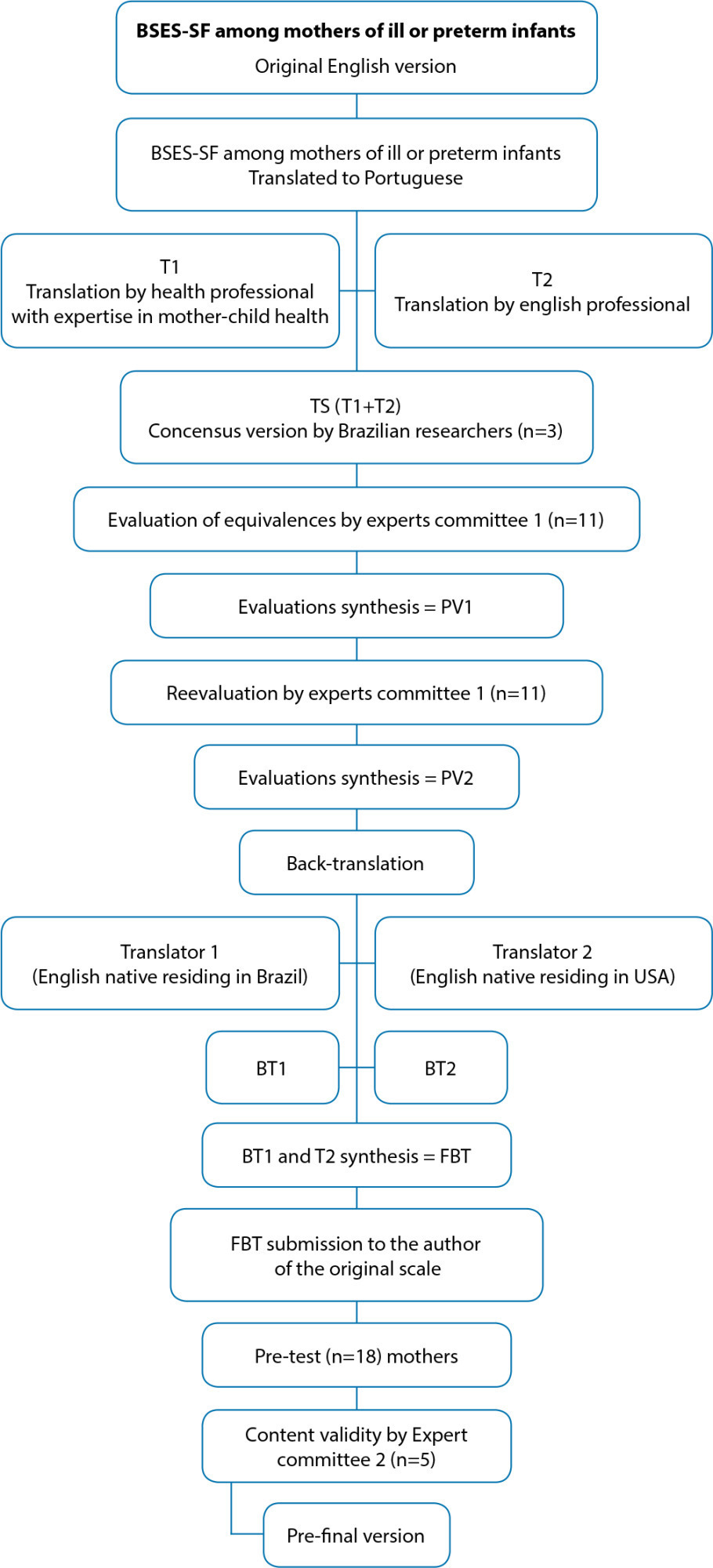
-
ORIGINAL ARTICLE11-27-2023
Puerperal women’s satisfaction with the obstetric services received: improvement of an assessment instrument
Revista Brasileira de Enfermagem. 2023;76(5):e20220457
Abstract
ORIGINAL ARTICLEPuerperal women’s satisfaction with the obstetric services received: improvement of an assessment instrument
Revista Brasileira de Enfermagem. 2023;76(5):e20220457
DOI 10.1590/0034-7167-2022-0457
Views0ABSTRACT
Objectives:
to improve an instrument that measures postpartum women’s satisfaction with obstetric care.
Methods:
action research, developed from a preliminary version of an instrument prepared by nurse-midwives working in public services in the Federal District. The analysis of the results of application of instrument carried out in a pilot test, analysis of evidence of instrument validity, literature review, focus group with the instrument’s developers and interview with the target audience were carried out.
Results:
factorial analysis showed three existing factors in the construct. Seven nurses participated, discussing the instrument reformulation, and 20 mothers reported their perceptions about the care received during childbirth, generating five thematic units.
Final Considerations:
instrument improvement occurred through item and response scale reconstruction and reorganization, in addition to application of a pre-test with the target population, resulting in an instrument composed of 13 items.
Keywords:Health Services ResearchParturitionPatient SatisfactionSurveys and QuestionnairesWomen's HealthSee more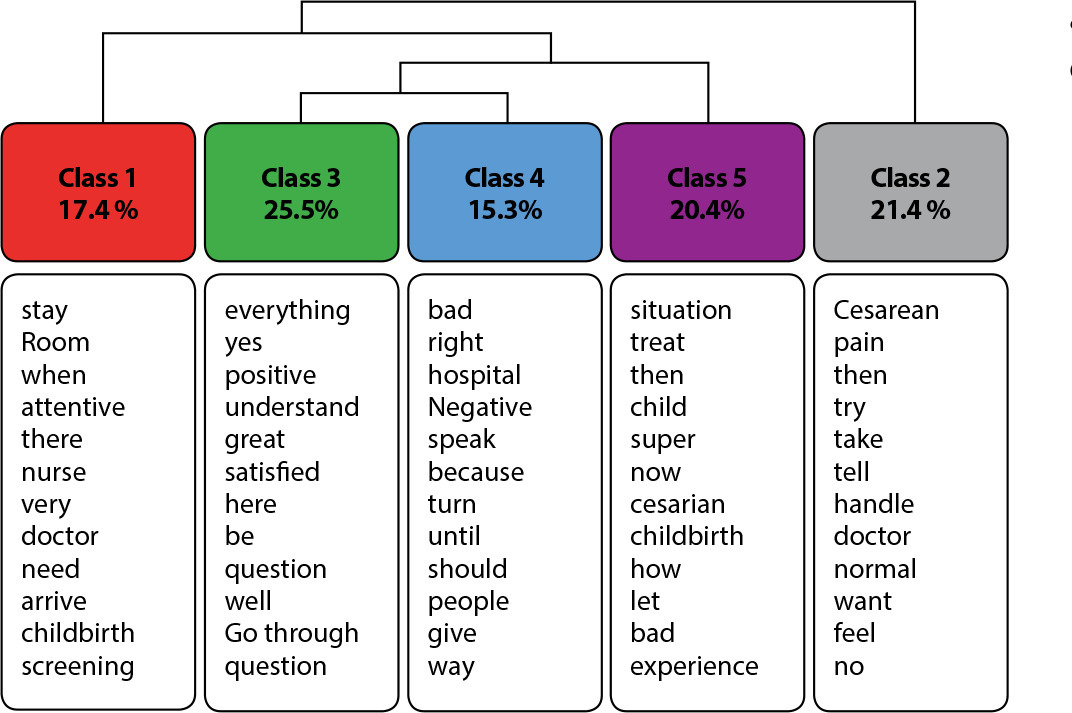
-
REVIEW11-27-2023
Proposta do diagnóstico de enfermagem “Retorno Venoso Periférico Prejudicado”: formação do conceito
Revista Brasileira de Enfermagem. 2023;76(5):e20220426
Abstract
REVIEWProposta do diagnóstico de enfermagem “Retorno Venoso Periférico Prejudicado”: formação do conceito
Revista Brasileira de Enfermagem. 2023;76(5):e20220426
DOI 10.1590/0034-7167-2022-0426
Views0RESUMEN
Objetivos:
desarrollar una propuesta de diagnóstico de enfermería centrada en el retorno venoso.
Métodos:
se trata de un análisis de concepto según el modelo propuesto por Walker y Avant, que se operacionaliza a través de una revisión integradora. El estudio se llevó a cabo de acuerdo con las recomendaciones del protocolo Preferred Reporting Items for Systematic Reviews and Meta-Analyses.
Resultados:
el análisis de los 131 estudios permitió identificar atributos, antecedentes y consecuencias. El atributo más común fue la disminución del flujo venoso. Los antecedentes encontrados con mayor frecuencia fueron deficiencia valvular estructural y/o funcional, edad avanzada y trombosis venosa periférica. Las consecuencias más comunes fueron edema periférico, úlcera venosa y dolor en la extremidad.
Conclusiones:
el diagnóstico de enfermería formulado fue propuesto como parte del Dominio 4, Actividad/reposo, en la Clase 4, Respuestas cardiovasculares/pulmonares, con ocho características definidoras, cinco factores relacionados, seis poblaciones de riesgo y cuatro condiciones asociadas.
Keywords:Diagnóstico de EnfermagemExtremidade InferiorFormação de ConceitoInsuficiência VenosaProcesso de EnfermagemSee more
-
RESEARCH01-01-2017
Unna’s boot: experience of care of people with venous ulcers
Revista Brasileira de Enfermagem. 2017;70(2):349-356
Abstract
RESEARCHUnna’s boot: experience of care of people with venous ulcers
Revista Brasileira de Enfermagem. 2017;70(2):349-356
DOI 10.1590/0034-7167-2016-0219
Views0See moreABSTRACT
Objective:
to understand the experience of care of people with venous ulcers using an Unna’s boot.
Method:
a qualitative study, based on the social phenomenology by Alfred Schütz, was carried out with 12 adults interviewed in 2015. The statements were analyzed and organized in thematic categories.
Results:
the following categories emerged: “Unna’s boot annoyance versus wound improvement”, “Difficulties for accessing care with the Unna’s boot”, “Care for healing and preventing recurrence”, and “Receiving more attention from the healthcare professional”.
Conclusion:
the experience of care of people using an Unna’s boot revealed the annoyance caused by this device, which was overcome due to the wound improvement. However, access to care was compromised by the lack of structure at the service, frustrating the patients’ expectations regarding wound healing. The issues of these people’s intersubjective universe should be considered in the management of care of venous ulcers.
-
RESEARCH01-01-2017
Spanish version of the scale of attitudes toward alcohol, alcoholism and alcoholics: content validation
Revista Brasileira de Enfermagem. 2017;70(2):342-348
Abstract
RESEARCHSpanish version of the scale of attitudes toward alcohol, alcoholism and alcoholics: content validation
Revista Brasileira de Enfermagem. 2017;70(2):342-348
DOI 10.1590/0034-7167-2015-0149
Views0See moreABSTACT
Objective:
to describe the process of translation and cultural adaptation of the scale of attitudes towards alcohol, alcoholism and alcoholics into the Spanish language.
Methods:
this was a methodological study, which followed the international guidelines for translation and adaptation of measurement scales.
Results:
During the process of translation and cultural adaptation of scale of attitudes towards alcohol, alcoholism and alcoholics to the Spanish language, the items were adjusted based on semantic, idiomatic and conceptual equivalence of the expressions contained in the scale of attitudes towards alcohol, alcoholism and alcoholics. Content validation indicated satisfactory validity indexes, with Intraclass Correlation Coefficient (ICC) (0.97), Content Validity Index (CVI) (0.92), and the Prevalence Adjusted Bias Adjusted Kappa (PABAK) (0.80).
Conclusion:
the scale of attitudes towards alcohol, alcoholism and alcoholics, adapted and translated into the Spanish language, presented content validity with satisfactory indexes, which affirmed that the instrument was adapted for the Colombian context. The next step will be evaluation of its psychometric properties in order to guarantee reliability for its use in Hispanic populations.
-
RESEARCH01-01-2017
Nursing care protocol for patients with a ventricular assist device
Revista Brasileira de Enfermagem. 2017;70(2):335-341
Abstract
RESEARCHNursing care protocol for patients with a ventricular assist device
Revista Brasileira de Enfermagem. 2017;70(2):335-341
DOI 10.1590/0034-7167-2016-0363
Views0See moreABSTRACT
Objective:
to develop and validate a nursing care protocol for patients with a ventricular assist device (VAD).
Method:
descriptive study, with a quantitative approach, for an instrument’s methodological validation. Three stages were conducted: development of the instrument; protocol content validation according to the Delphi technique, and agreement among experts and the scientific literature.
Results:
based on the content validation, a care protocol for patients with a VAD was created and assessed by Spanish experts. Of the 15 items evaluated by means of the content validity index (CVI), 10 presented solid evidence of validation, with Kappa ranging between 0.87 and 1.
Conclusion:
the method enabled the validation of interventions that will contribute to qualified and standardized care for patients with a VAD.
-
RESEARCH01-01-2017
Nasoenteral tube: factors associated with delay between indication and use in emergency services
Revista Brasileira de Enfermagem. 2017;70(2):326-334
Abstract
RESEARCHNasoenteral tube: factors associated with delay between indication and use in emergency services
Revista Brasileira de Enfermagem. 2017;70(2):326-334
DOI 10.1590/0034-7167-2016-0222
Views0ABSTRACT
Objective:
to know the time between indication and use of a nasoenteral tube (NET) and factors associated with delays.
Method:
A prospective cohort study that followed adults in a Brazilian emergency department, since the indication of the use of a NET, evaluating clinical variables and the work process. The Generalized Estimated Equations model was adopted to identify factors associated with the delays in each stage of the process.
Results:
the time between indication and use of NET was 573 (IQR: 3601,093) minutes, in 150 insertions of NET. Insertions in patients who previously did not use it; delays in the medical, nutrition, and nursing care routine; use of mechanical ventilation; noradrenaline; and fasting were factors for longer time before the use of the tube.
Conclusion:
the time between indication and use of NET was high, exceeding 10 hours in half of the cases. Factors related to the clinical condition of the patient and to the care management would contribute to delays.
Keywords:Emergency Medical ServicesGastrointestinal IntubationNursing CarePatient SafetyTreatment TimeSee more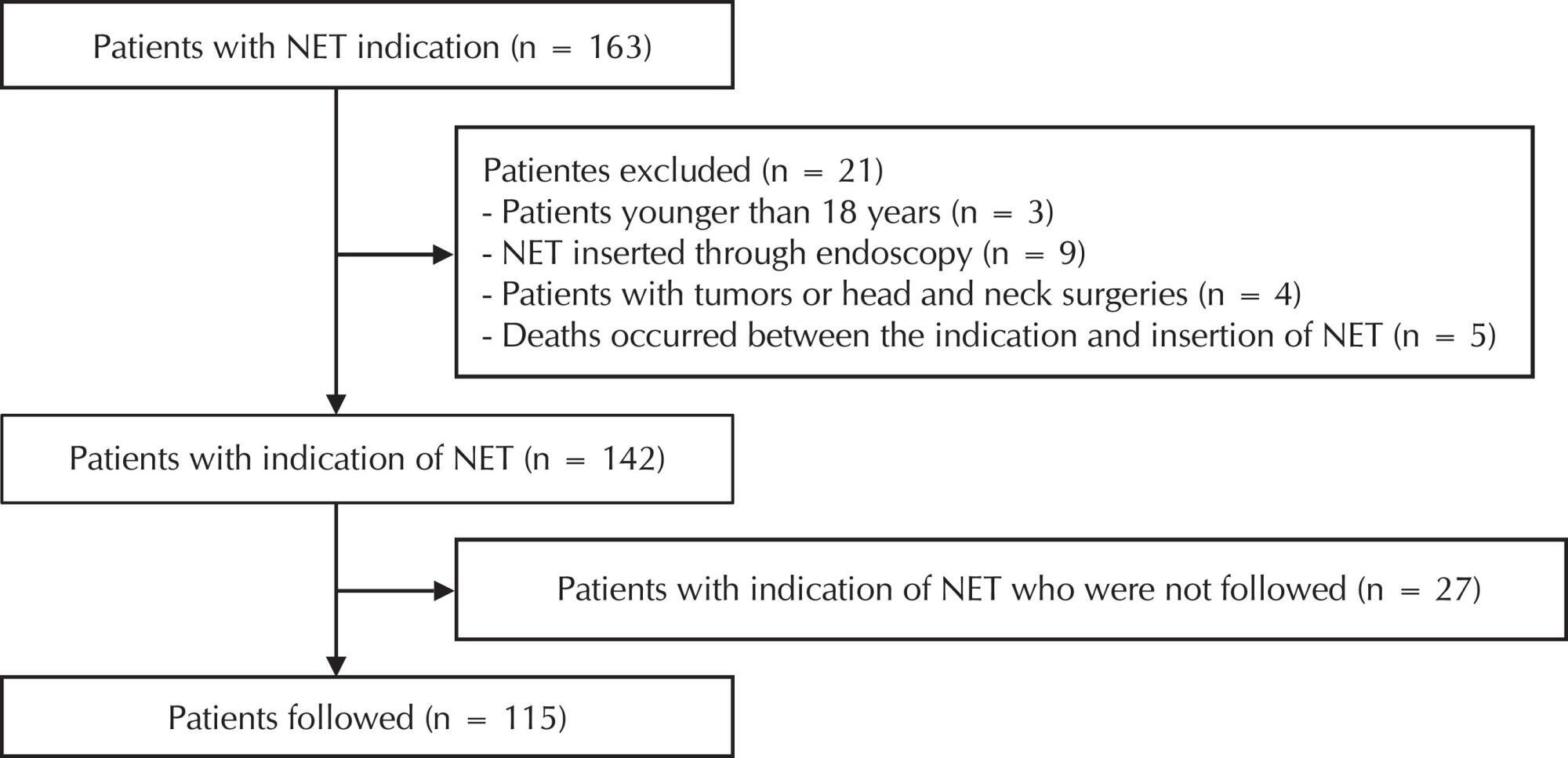
-
RESEARCH01-01-2017
Non-pharmacological measures in preterm newborns submitted to arterial puncture
Revista Brasileira de Enfermagem. 2017;70(2):317-325
Abstract
RESEARCHNon-pharmacological measures in preterm newborns submitted to arterial puncture
Revista Brasileira de Enfermagem. 2017;70(2):317-325
DOI 10.1590/0034-7167-2016-0003
Views0See moreABSTRACT
Objective:
to assess pain in preterm newborns and to compare the neonatal and therapeutic variables with the total scores of the Neonatal Facial Coding System of preterm newborns submitted to arterial puncture exposed to music and 25% oral glucose.
Method:
a comparative study with 48 recordings of preterm newborns – Group 1, music (26); Group 2, glucose 25% (22) – individually analyzed by three trained nurses, after Kappa of at least 80%.
Results:
the variables and the pain scores of the groups did not present statistical significance (p < 0.05) according to the Neonatal Facial Coding System. 80.8% of the preterm infants in Group 1 had a higher quantitative score ≥ 3 in the neonatal variables (gender, type of delivery), and therapeutic variables (type of oxygen therapy, place of hospitalization, type of puncture).
Conclusion:
There was no difference when comparing the music and glucose 25% groups and the variables studied.
-
RESEARCH01-01-2017
Moral sensitivity in Primary Health Care nurses
Revista Brasileira de Enfermagem. 2017;70(2):308-316
Abstract
RESEARCHMoral sensitivity in Primary Health Care nurses
Revista Brasileira de Enfermagem. 2017;70(2):308-316
DOI 10.1590/0034-7167-2016-0453
Views0See moreABSTRACT
Objective:
to characterize the profile and describe the moral sensitivity of primary health care nurses.
Method:
this is a quantitative, transversal, exploratory, descriptive study. The data were collected through the Moral Sensitivity Questionnaire translated and adapted to Brazil. 100 primary health care nurses participated, from Rio Grande do Sul, Brazil. The data collection took place during the months of March and July 2016, in an online form. The analysis of the data occurred through descriptive statistical analysis.
Results:
the nurses had an average moral sensitivity of 4.5 (out of 7). The dimensions with the greatest moral sensitivity were: interpersonal orientation, professional knowledge, moral conflict and moral meaning.
Conclusion:
the nurses of Rio Grande do Sul have a moderate moral sensitivity, which may contribute to a lower quality in Primary Health Care.
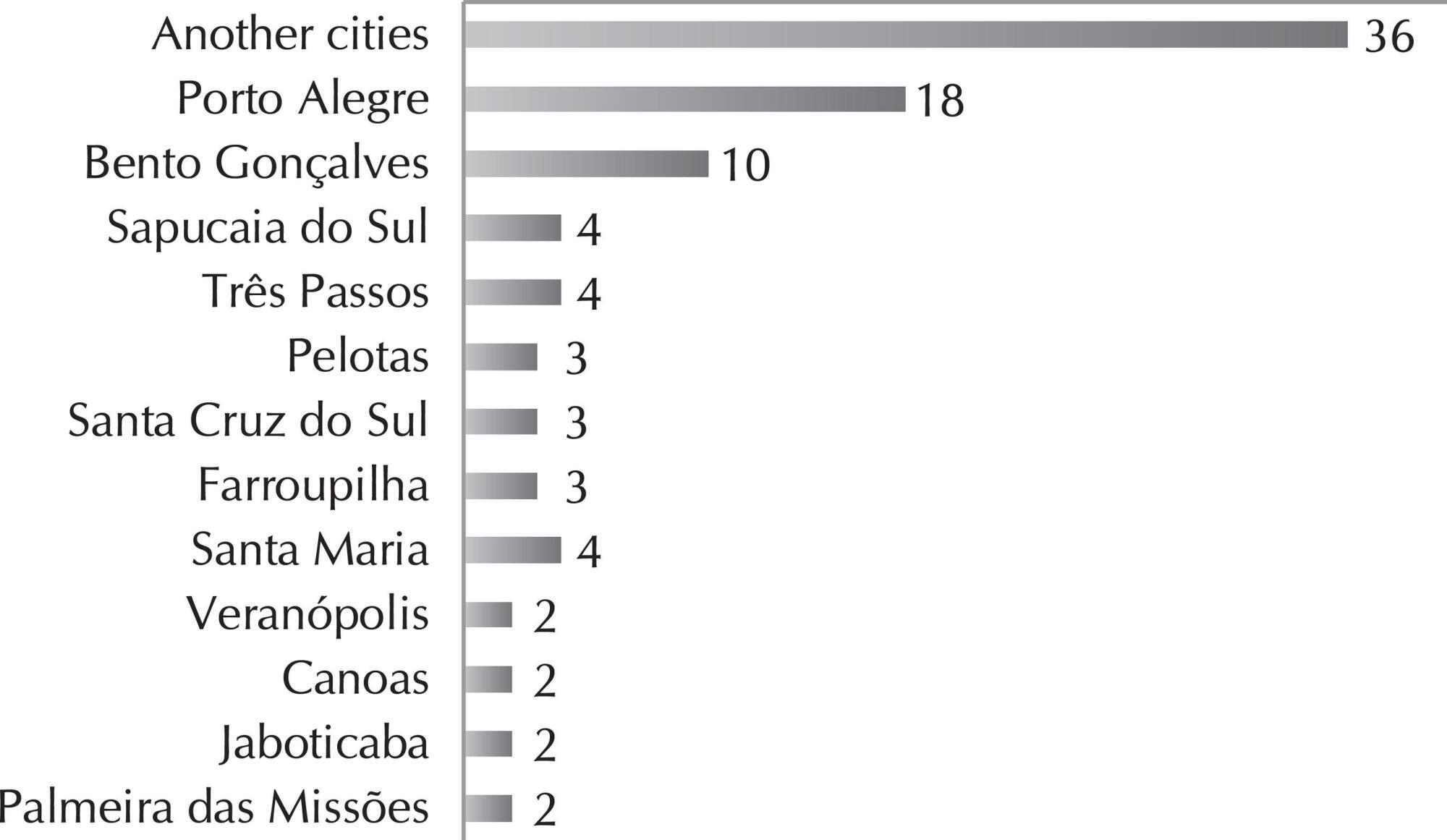
-
RESEARCH01-01-2017
Moral suffering among nurse educators of technical courses in nursing
Revista Brasileira de Enfermagem. 2017;70(2):301-307
Abstract
RESEARCHMoral suffering among nurse educators of technical courses in nursing
Revista Brasileira de Enfermagem. 2017;70(2):301-307
DOI 10.1590/0034-7167-2016-0185
Views0See moreABSTRACT
Objective:
to understand situations of moral suffering experienced at work by nurse educators of technical courses in nursing.
Method:
a qualitative study with discursive textual analysis by means of semi-structured interviews with ten nurse educators at two professional educational institutions in southern Brazil.
Results:
two categories were established: lack of commitment on the part of students to the future profession, expressed through disrespect and disregard for the work of nurse educators, with inappropriate behaviors and attitudes; and lack of commitment to the learning-teaching process, expressed by indifference to the professional profile and lack of interest in lessons and care practices associated with learning gaps.
Conclusion:
these situations have an impact on experiences of moral suffering by nurse educators, and show a need for rethinking their practice, relationships, and educational spaces, and implementing strategies to favor the confrontation of dilemmas and conflicts experienced in educational practice in technical courses in nursing.
-
RESEARCH01-01-2017
Knowledge of the nursing team on pressure ulcer prevention
Revista Brasileira de Enfermagem. 2017;70(2):294-300
Abstract
RESEARCHKnowledge of the nursing team on pressure ulcer prevention
Revista Brasileira de Enfermagem. 2017;70(2):294-300
DOI 10.1590/0034-7167-2016-0063
Views0See moreABSTRACT
Objective:
describe and analyze the nursing team’s knowledge about classification, evaluation and measures to prevent pressure ulcers (PU) in patients hospitalized in the ICU of a teaching hospital in the city of Manaus.
Method:
a descriptive and exploratory study was conducted after approval by a research ethics committee. Data were collected using a validated instrument. The study sample was made up of 40 nursing staff members, of whom 14 were nurses and 26 were nursing technicians/aides. Data were analyzed through descriptive statistics and Student’s t-test, with value of p<0.05.
Results:
the overall mean of hits was 63.4% for technicians/aides and 51.4% for nurses, with statistically significant differences between the groups only for the PU prevention category (p<0.001).
Conclusion:
a deficit of knowledge on PU prevention was found among nurses and nursing technicians/aides, demanding the training of these professionals.
Search
Search in:
Nuvem de Tags
Aged (144) Atenção Primária à Saúde (239) COVID-19 (104) Cuidados de Enfermagem (269) Educação em Enfermagem (151) Educação em Saúde (139) Enfermagem (930) Estudos de Validação (131) Health Education (144) Idoso (208) Mental Health (149) Nursing (987) Nursing Care (306) Patient Safety (151) Primary Health Care (284) Qualidade de Vida (104) Quality of Life (106) Saúde Mental (145) Segurança do Paciente (150) Validation Studies (108)




